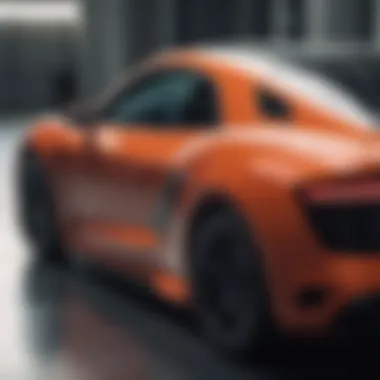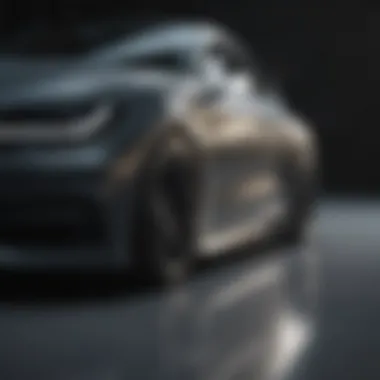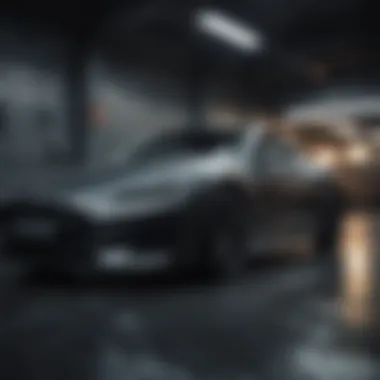Evaluating the Best Car Tint Materials for Your Vehicle


Intro
In today's automotive market, the relevance of car tint materials cannot be overstated. Drivers and enthusiasts increasingly seek out optimal products that enhance not just appearance, but also protect against sunlight and increase comfort. Selecting the best car tint materials requires understanding various attributes, such as heat rejection capabilities, UV protection, durability, and compliance with local regulations.
This guide aims to provide a thorough analysis of the types of materials available. By looking at each option’s merits and challenges, we can elucidate which may be the most advantageous for different vehicles. With this comprehension, car buyers and owners can derive maximum benefit from their investment in tint, expanding beyond aesthetic choices to functional ones.
Detailed Car Reviews
Overview of Vehicle Design and Aesthetics
Car tint applications frequently correspond to vehicle aesthetics. The various materials available offer an array of appearances and benefits. Darker tints are known to amplify a vehicle's muscular aesthetics, imparting a certain premium feel. Conversely, lighter shades may accentuate a more understated look. Some tints even offer unique patterns or finishes that cater to individual style preferences.
Brands like LLumar and 3M offer tints that fuse functionality with style, utilizing advanced technology to improve both design and utility. Therefore, an understanding of how different materials integrate into a vehicle's overall design is crucial.
Interior Features and Comfort
Factors such as heat rejection play a significant role in interior comfort. Some films block a noteworthy amount of infrared light, but the quality of materials matters significantly. For instance, ceramic films are praised for excellent heat blocking without altering the interior's visibility. When shopping for car tints, it is important to prioritize materials that enhance comfort reduction by keeping the cabin cooler in high temperatures.
Performance Metrics and Test Drive Experience
To ascertain performance, determining how well a tint retains its properties over time is vital. High-quality tint materials withstand elements better. Qualities such as scratch resistance and adhesive durability go hand-in-hand with heat rejection capabilities. Conducting thorough research and reading consumer reviews may shed light on the long-term efficacy of selected tints used in various conditions.
Fuel Economy and Efficiency
While it seems peripheral, efficient window tinting can positively influence fuel economy. Less temperature regulation from the HVAC systems translates into lower fuel consumption. The demand for energy-efficient solutions only rises, making this factor more relevant. Materials that provide sufficient heat rejection not only keep cabin temperatures down but also play a role when fueling your vehicle.
Safety Ratings and Technologies
Certain kinds of tints can even elevate safety, offering added protection against shattering upon accidents. Tints provide enhanced security as well. This aspect intertwines with innovative technologies. Various manufacturers offer tints that are impact-resistant, serving dual purposes of aesthetic appeal and safety enhancement. Understanding the nuances of these innovations affords car owners substantial advantages.
Ending
To summarize, evaluating car tint materials encompasses various attributes beyond aesthetics. It is an investment into practical qualities including comfort, safety, and efficiency. By assimilating this knowledge, it enables car enthusiasts and buyers alike to make informed decisions concerning their choices. With clarity on demand for choice compatibility with vehicle functionalities, driver experience can be significantly enhanced.
Understanding Car Tinting
Car tinting is a crucial aspect of automotive customization and functionality. Many vehicle owners overlook the importance of window films, which serve not just aesthetic purposes but also offer practical benefits like improved comfort and protection.
A fundamental benefit of car tinting is heat rejection. Tinted windows can significantly reduce the interior temperature of a vehicle, making driving more comfortable especially in hot climates. This ensures that the air conditioning system does not have to work as hard, thus improving fuel efficiency.
Moreover, car tinting provides UV protection. Ultraviolet rays can cause skin damage and deteriorate the interior materials of the car; tinted windows can block a major portion of these harmful rays. In addition to health safety, tinting also protects the vehicle’s upholstery by minimizing fading.
An important consideration is also the overall privacy that car tint material provides. Tints ranging from light to dark can obscure the view into the vehicle, enhancing personal security by keeping valuables out of sight.
Beyond these benefits, understanding car tint also involves recognizing the legal implications based on one’s location. Local laws may dictate how dark or reflective a tinted window can be, and failing to comply may result in penalties. Hence, it is key to be informed about the regulations that apply where one lives.
“Tinting is more than just for looks; it’s about understanding what fits best with your lifestyle, climate, and local regulations.”
Understanding these elements contributes to educated choices when selecting tint materials, allowing one to balance both style and compliance effectively.
Importance of Car Tinting
The importance of car tinting cannot be understated. It serves multiple functions that contribute to overall vehicle performance and owner satisfaction. First, the enhancement of driving comfort through substantial heat reduction stands as a primary reason many choose tinting. Secondly, the health benefits from UV protection accentuates its role in safeguarding the wellbeing of all occupants inside the vehicle.
Furthermore, the aesthetic appeal of tinted windows complements the vehicle's design. A well-executed tint can elevate the overall look, giving the car a sleek profile and improved style. Additionally, privacy provided by window films adds significant value, making drivers feel safer and more secure.
Finally, considering the legal aspects makes proper tinting even more crucial. Knowledge about allowable limits on tints averts unnecessary fines and ensures complete compliance with local laws. Thus, by comprehending the importance of car tinting, owners can reap the best benefits from this valuable enhancement.
Overview of Tinting Laws


Understanding car tinting also entails a close look at tinting laws specific to one’s state or country. Regulations can vary widely, impacting how one chooses to tint their car. Many jurisdictions set limits on the visual light transmission (VLT) percentage for each window. For instance, some regions allow for darker tinting on the rear windows than on the driver and passenger front windows.
One also needs to consider reflectivity limits. While some materials boast high reflective properties, not all areas permit high levels of reflectivity for safety reasons—especially concerning nighttime visibility.
In addition, certain locations may have specific requirements for tinting products used, dictating that films must meet prescribed standards. Failing to comply with these laws can lead to additional fees and necessitating removal or referral. Therefore, gaining a clear understanding of tinting laws is crucial, enabling vehicle owners to make decisions that legally align with their tinting desires. Knowing the rules provides confidence in customizing the vehicle safely and effectively.
Types of Car Tint Materials
The choice of car tint materials cannot be understated. It influences not just aesthetics but also the car’s functionality, energy efficiency, and passenger comfort. Different materials cater to various preferences and needs. Mining through the types enhances the decision-making process for automotive enthusiasts and casual car buyers alike. Not all tints provide the same level of UV protection or heat rejection; hence understanding materials is essential.
Dyed Window Tint
Composition and Structure
Dyed window tint is among the most straightforward options available. It mainly consists of a dyed layer of film applied to the glass surface. The dye absorbs solar energy and converts it into heat, which is then dissipated outside. A significant characteristic is the relative simplicity and affordability of the composition. This simplicity makes dyed window tint a popular choice for drivers seeking cost-effectiveness. However, it can fade over time, reducing its effectiveness.
Benefits and Limitations
The primary benefit of dyed window tint lies in its ability to enhance privacy. The darker shade can deter prying eyes, contributing to security. Additionally, it blocks a proportion of harmful UV rays, improving both comfort and safety inside the vehicle. However, a notable limitation is the reduced longevity and performance decline against more advanced materials. Understanding these aspects can guide buyers in choosing what suits their needs best.
Metalized Window Tint
Reflective Properties
Metalized window tint is unique for its reflective properties. The film is infused with tiny metallic particles that can reflect heat. This quality results in notable energy savings for those frequently parked in sunlight. The reduced heat absorbs is not only significant for user comfort but equally provides enhanced durability compared to dyed tints. While this option speaks to energy efficiency, the potential drawback lies in its reflective surface leading to altered aesthetic appeal.
Impact on Signal Reception
A crucial consideration with metalized window tint is its impact on signal reception for devices like cell phones it might affect communication and navigation systems. Users should weigh their need for signal clarity against the benefits observed with heat reduction. The serviceability of this type becomes important here; balancing cooling benefits while considering possible signal blockage creates an intriguing point of discussion for potential users.
Ceramic Window Tint
Advanced Technology
Ceramic window tint embodies a significant technological advancement over traditional options. It utilizes non-metallic ceramic particles, ensuring it remains lightweight yet effective against solar heat. A primary characteristic is improved infrared blocking without compromising visibility. Thus it is particularly suited for those looking for maximum performance devoid of reflective drawbacks, reflecting an appealing transition in technology for car tinting.
Performance Metrics
When evaluating performance metrics, ceramic tint excels in various facets such as UV protection, glare resistance, and sustained longevity. Unlike standard options, ceramic tints maintain their color and performance over time. This longevity is significant in assessing value. Yet, the high cost associated with ceramic options may limit its accessibility, leading buyers to balance expenses against merits.
Carbon Window Tint
Durability and Appearance
Carbon window tint stands out due to its remarkable durability and unique appearance. Completely free of metals and dyes, the carbon layer ensures stability against fading. A critical advantage of this material is the modern, sleek look it provides while being effective against UV and heat rejection. Despite its high price, many users view it as a long-term investment in their vehicle’s aesthetic and functional quality.
Heat and UV Rejection
In terms of heat and UV rejection, carbon window tint performs exceptionally well compared to competitors. The advanced coating holds the ability to reject a significant percentage of solar energy, ensuring interior temperature is more manageable. Encouragingly, buyers benefit from reduced energy costs if equipped with functional energy solutions. The trade-off, however, remains steep pricing and availability depending on local stores.
Performance Comparison of Tint Materials
Understanding the performance comparison of different tint materials is pivotal when selecting car window tinting solutions. This analysis highlights significant elements such as UV protection, heat rejection capabilities, and the aspects of visibility and aesthetics. Each of these components plays a crucial role in how effectively the tint material serves its purpose by enhancing comfort, safety, and overall vehicle appeal.
UV Protection
One of the foremost reasons for applying tints on car windows is UV protection. Ultraviolet rays can damage both skin and vehicle interiors, leading to fading and other deterioration. The effectiveness of various car tint materials in blocking these rays is essential in assessing their worth. Good tints can block up to 99% of harmful UV rays. This diminishes skin-related health risks and reduces heat buildup within the vehicle.


The materials typically assessed include dyed, metalized, ceramic, and carbon tints. Each type offers a different level of UV protection based on its formulation. Ceramic materials tend to provide superior UV blockage thanks to their advanced technology. On the other hand, dyed tints generally allow significant light but might not perform as well in blocking UV rays. Comprehensive evaluation and comparison can help users make informed decisions based on what suits their situation best.
Heat Rejection Capabilities
Heat rejection capabilities is another essential measure. Tinted windows should ideally deter the penetration of heat, promoting greater comfort within the car. Excessive heat can lead to discomfort for all passengers during hot weather. Moreover, effective heat rejection can help alleviate the load on air conditioning systems, potentially improving fuel efficiency.
The ranking here significantly varies. Ceramic tint often showcases exceptional performance due to its capability to reject heat effectively. Metalized tints also provide decent heat rejection but interfere with electronic devices. Dyed tints offer minimal thermal insulation. Understanding these capabilities is crucial for drivers who anticipate rigorous weather conditions.
Visibility and Aesthetics
Finally, providers of car tints should also think about visibility and aesthetics, as the visual quality affects safety and appeal. The right tinting solution should allow proper visibility, especially at night, while enhancing the vehicle's exterior look.
Various factors can influence the transparency of different tint types. Generally, ceramic tints have excellent clarity without compromising aesthetics. Carbon film can capture a sleek and modern appearance but might show glare under certain conditions. Unlike these options, dyed and metalized tints might not always provide optimal nighttime visibility due to their inherent characteristics.
Reducing visual obstructions while adding aesthetic value is a balancing act with considerable importance. The ultimately best choice ensures safety along with visual gratification.
Choosing the right window tint can improve comfort and protect your investment over the long haul.
Factors Influencing Material Selection
When considering the choice of car tint materials, several key factors come into play. Each aspect shapes not only the visual appeal of a vehicle but also the performance and compliance with the law. This guide aims to dissect the elements of selection, providing clarity to automotive enthusiasts and potential buyers navigating the complexities of car tinting.
Vehicle Type and Usage
The type of vehicle and its intended use are significant factors that influence material selection for car tinting. Different vehicles, whether sedans, SUVs, or sports cars, may require specific tint materials to achieve the desired look and performance. For instance, a typical family SUV might benefit from lighter tints that offer comfort without obstructing visibility, while a sports car may opt for darker, sleeker tinting materials suitable for enhancing aesthetics and safeguarding privacy.
Factors to consider include:
- Driver Demographics: Young drivers may prefer darker tints for style, whereas older drivers might prioritize visibility and safety.
- Passenger Needs: If the vehicle is often occupied by children or elderly passengers, an emphasis on UV protection and comfort becomes critical.
- Usage Frequency: A vehicle used for work purposes may not only demand durability but also easy maintenance. Reliable materials, such as ceramic or carbon, may be ideal.
Choosing the right tint material is highly dependent on the vehicle's use and owner preferences.
Climate Considerations
Climate plays an essential role in the choice of car tint materials. Different regions experience varying temperatures and sunlight exposure, impacting how effective a tint can be. In sunnier locations, a tint material that excels in UV protection and heat rejection is vital.
Key climate considerations include:
- Heat Rejection Requirements: For hot climates, professional-grade films that block infrared rays while lowering the internal temperature of the vehicle will prove beneficial.
- Cold Weather Adaptability: In colder regions, homeowners may worry about fade and wear over time. Research into longevity under harsh weather conditions becomes important.
- Humidity and Rain: Durable materials that withstand high humidity without warping or peeling add practical value.
Local Tinting Regulations
Finally, local laws and regulations establish crucial boundaries when it comes to car tinting. Every state, country, or municipality will have specific laws addressing tint darkness, reflection levels, and the allowable percentage of light transmission. Understanding these regulations is essential for compliance and ensuring the safety of all road users.
Elements to investigate include:
- Brightness Limitations: Each location will specify different limits on how dark tints can be. Failing to comply may result in tickets or fines.
- Reflectivity Standards: Some areas might impose restrictions on how reflective the material can be, impacting choices especially for metalized tints.
- Exceptions for Medical Reasons: Certain regions allow exceptions that permit darker tints for individuals with medical conditions. Knowing these provisions can influence choices.
Understanding these factors comprehensively positions the consumer to make informed decisions when choosing car tint materials. Balancing vehicle type, climate demands, and adherence to regulations leads to a tailored approach that augments both functionality and style.
Installation Guidelines
Installation is a critical aspect of the car tinting process. The effectiveness and longevity of the tint largely depend on how well it is applied. Understanding installation guidelines not only aids in enjoying the benefits of tinted windows but also safeguards the integrity of your vehicle's surfaces. Appropriate installation can enhance aesthetic appeal, improve UV protection, and ensure efficient heat rejection.
DIY vs.
Professional Installation


When deciding between DIY and professional installation, several factors come into play. Choosing the DIY route may tempt some because of perceived cost savings. It allows for flexibility and personal engagement in the process. However, this approach requires a level of skill and knowledge about tools and material behavior. All windows may not have the same shape or size, making it challenging to apply tints fluidly.
On the other hand, professional installation from a reputable shop ensures that the task is done correctly. Professionals possess both the experience and the tools necessary for high-quality results. Moreover, most professionals offer warranties that can cover any issues post-installation, providing peace of mind.
In summary, while DIY installation can be satisfying, professional installation could save effort and lead to optimal outcomes.
Preparation and Application Tips
Proper preparation is essential before engaging in the tint application process. Start by cleaning the windows thoroughly to remove dirt, debris, and old adhesive residue. This step ensures good adherence of the tint film.
Some valuable tips to consider during the application phase include:
- Temperature: Tint applications are best done in controlled environments. Ideally, it should be between 50°F and 85°F.
- Water as a Tool: When applicable, use a water-and-soap mixture for facilitating the installation. It allows for adjustments during application.
- Edge Sealing: Ensure that all edges of the tint gather well along the window seals. Poor sealing may lead to peeling or bubbling over time.
Follow-up maintenance is equally essential for preserving the application. Avoid cleaning the newly tinted windows for at least 48 hours to allow adequate bonding.
Through adhering to these guidelines, you can maximize both the appearance and performance of your car's window tint, whether you decide to tackle the project yourself or hire experts.
Maintenance and Care for Tinted Windows
Maintaining and caring for tinted windows is crucial for preserving the aesthetic appeal and functionality of your vehicle. Proper care can significantly enhance durability and optimize performance. Over time, window tints may experience wear if not properly maintained, leading to less effective UV protection and decreased heat rejection abilities. Regular maintenance not only keeps the tint looking fresh but also helps extend its lifespan.
Some key benefits of maintaining tinted windows include improved clarity of vision, maximum sun protection, and reduction in heat buildup inside the vehicle. But without adequate care, even the highest quality materials can degrade. Hence, understanding how to effectively maintain your car tint is essential.
Cleaning Products and Techniques
When it comes to cleaning tinted windows, the choice of products and techniques used makes a significant difference.
- Use Non-Abrasive Cleaners: Always opt for cleaning solutions specifically designed for tinted windows or a mild soap solution to avoid damage.
- Soft Cloths or Microfiber: A soft cloth or microfiber cloth is recommended to prevent scratching. Paper towels can retain glazing that is not good for the tinted film.
- Spray and Wipe: Lightly spray the cleaner until it’s moist. Avoid excessive soaking to prevent any running into the edges.
- Avoid Concentrated RDvenes: When cleaning, refrain from using strong solvents, ammonia-based cleaners, or harsh oils, which can dissolve the tint.
Following these steps helps ensure that tint retains its intended darkening effect and protective qualities while maintaining a solid visual barrier. Cleaning should be done regularly to handle dust, fingerprints, or other grime that may collect over time.
Longevity and Performance Retention
The lifespan and performance retention of tinted windows are influenced by various factors, including initial material quality, environmental impacts, and the regularity of maintenance operations. By prioritizing proper care, you contribute to optimal longevity.
Tinted windows can last anywhere from five to fifteen years, depending on the material used, application method, and road conditions. Key factors influencing longevity include:
- Type of Tint: Quality and composition matter. Higher-tier materials such as ceramic tints generally exhibit extended durability.
- Installation Quality: Professional installation can ensure a superior bond to the glass surface, reducing the chance of peeling or bubbling.
- Exposure to Elements: Consistent UV exposure and extreme temperature fluctuations can weaken tints if proper care is neglected.
Recommendation: Regular inspections of the tinted windows can help identify signs of wear. Catching issues early can prevent facing total replacement later, preserving both aesthetics and functionality.
As a finishing note, routine maintenance not only achieves the appeal but ensures your tint contributes to the overall effectiveness of heat and UV rejection, safeguarding the car's interior and enhancing driving comfort.
End: Choosing the Best Car Tint Material
Choosing the right car tint material involves several key considerations that impact not only the functionality of the window film but also its aesthetic appeal and longevity. Throughout this guide, various materials have been discussed, each with their unique benefits and disadvantages relevant to specific applications.
First and foremost, understanding the performance metrics—such as UV protection, heat rejection, and visual clarity—can significantly influence decision-making. Quality window tint can provide up to 99% UV protection, safeguarding both the vehicle's interiors and its occupants from harmful sun exposure. Meanwhile, effective heat rejection can contribute to enhanced comfort during the hot months and potentially lower air conditioning use.
Next, it's crucial to consider the type of vehicle, which can dictate material choice. Sedans and trucks may have different requirements compared to luxury or sports cars. For instance, someone driving a family sedan may prioritize longevity and heat rejection, making ceramic or carbon options appealing.
The local climate is another vital factor. If you inhabit a region with extreme sunlight, investing in higher quality materials that excel in heat rejection becomes essential. Alternatively, a location with milder conditions may allow for more budget-friendly choices without significant drawbacks in performance.
Moreover, being aware of tinting laws is important. Regulations can include restrictions on tint darkness and reflectivity; hence, compliance is non-negotiable. Choosing a tint material that aligns with these regulations assures peace of mind regarding lawful vehicle operation.
Ultimately, the purchase of car tint material is not merely an aesthetic choice; it represents a commitment to quality, protection, and sustainability. Thus, considering the detailed analyses provided in this guide can lead to a more informed selection process.
A threesome analysis of price, performance, and purpose will yield focused outcomes in choosing the best car tint material.
Key Considerations for Selection
- Performance Metrics: Evaluate UV protection, heat rejection, and visibility.
- Vehicle Type: Take into account the specific recommendations based on vehicle usage.
- Climate Conditions: Assess the importance of comfort based on local temperatures.
- Legal Compliance: Know the local regulations to choose suitable options.
In summary, making the right decision about car tint materials can enhance your driving experience by balancing aesthetics, functionality, and compliance. Your vehicle deserves a tint solution that reflects excellence without compromising on fundamental necessities.







